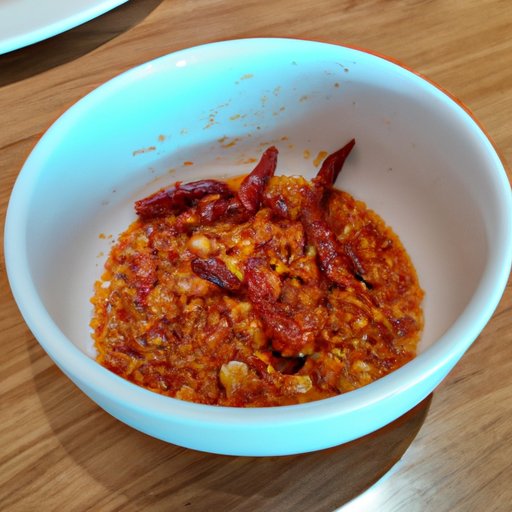Introduction
Spicy food is a common part of many cuisines around the world, from Mexican dishes to Indian curries. Generally speaking, “spicy” refers to food that has been prepared with a combination of herbs, spices, or peppers that give it a hot and often intense flavor. While some people love the kick that comes from eating spicy food, for others it can be an uncomfortable experience.
If you want to enjoy spicy food without pain, there are several things you can do. In this article, we’ll explore the best tips and tricks for eating spicy food without pain.
Start with Small Amounts of Spice
One of the best ways to get used to eating spicy food is to start with small amounts of spice and gradually increase the amount. This will allow your body to get used to the heat while also allowing you to enjoy the flavor of the dish. Additionally, if you find that the dish is too spicy, you can always add more of the milder ingredients or add a cooling ingredient such as yogurt or cream.
For example, if you’re making a curry, start by adding a small amount of chili powder or cayenne pepper. Taste the dish and then decide if you want to add more. You can also experiment with different types of peppers such as jalapenos or habaneros to find one that works for you.
Drink Water or Milk
Another good way to reduce the pain of eating spicy food is to drink water or milk while you’re eating. The liquid helps to dilute the heat of the spices and cool your mouth. Additionally, drinking milk can help to coat your tongue and reduce the intensity of the spiciness.
It’s important to note that drinking alcoholic beverages will not help to reduce the spiciness of a dish. In fact, alcohol can actually make the spiciness worse, so it’s best to avoid it when eating spicy food.
Use Cooling Ingredients
Using cooling ingredients is another great way to reduce the spiciness of a dish. Cooling ingredients such as yogurt, cream, avocado, and cucumber can help to balance out the heat of the spices and make the dish more enjoyable. These ingredients also add texture and flavor to the dish, making it even more delicious.
For example, if you’re making a curry, try adding a few tablespoons of plain yogurt or cream to the dish. The cooling effect of the dairy will help to reduce the spiciness while also adding a creamy texture to the dish.
Add Sugar
Adding sugar to a dish can also help to reduce the spiciness. The sweetness of the sugar can help to balance out the heat of the spices and make the dish more enjoyable. If you’re using sugar, make sure to use a type of sugar that won’t overpower the flavor of the dish, such as white sugar or brown sugar.
For example, if you’re making a spicy stir-fry, try adding a teaspoon of sugar to the dish. The sweetness of the sugar will help to balance out the spiciness of the dish while still maintaining the flavor.
Eat Slowly
Eating slowly is also key to enjoying spicy food without pain. Eating quickly can cause the spiciness of the dish to become overwhelming, so take your time and savor each bite. Additionally, chewing your food thoroughly will help to spread the heat throughout your mouth, reducing the intensity of the spiciness.
If you find yourself getting overwhelmed by the spiciness, try taking a few sips of water or milk between bites. This will help to reduce the intensity of the spiciness and make it easier to keep eating.
Choose Milder Spices
When cooking with spices, it’s important to choose milder varieties. Some spices, such as cayenne pepper, can be very intense and can easily overwhelm a dish. Instead, opt for milder spices such as paprika, chili powder, or garlic powder. These spices will still add flavor to the dish but won’t be as overwhelming.
For example, if you’re making a spicy soup, try using a milder variety of chili powder or paprika instead of cayenne pepper. The milder spices will still add flavor to the dish but won’t be as intense.
Add Fat
Finally, adding fat to a dish can also help to reduce the spiciness. Fats such as butter, coconut oil, and olive oil help to coat the tongue and reduce the intensity of the spiciness. Try adding a tablespoon or two of fat to the dish before serving to reduce the spiciness.
For example, if you’re making a spicy curry, try adding a tablespoon of coconut oil or olive oil to the dish before serving. The fat will help to reduce the spiciness while also adding a flavorful richness to the dish.
Conclusion
Eating spicy food doesn’t have to be a painful experience. With the right tips and tricks, you can enjoy the flavor of spicy food without feeling overwhelmed. Try starting with small amounts of spice, drinking water or milk, using cooling ingredients, adding sugar, eating slowly, choosing milder spices, and adding fat to reduce the spiciness of a dish.
(Note: Is this article not meeting your expectations? Do you have knowledge or insights to share? Unlock new opportunities and expand your reach by joining our authors team. Click Registration to join us and share your expertise with our readers.)
